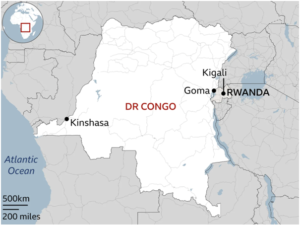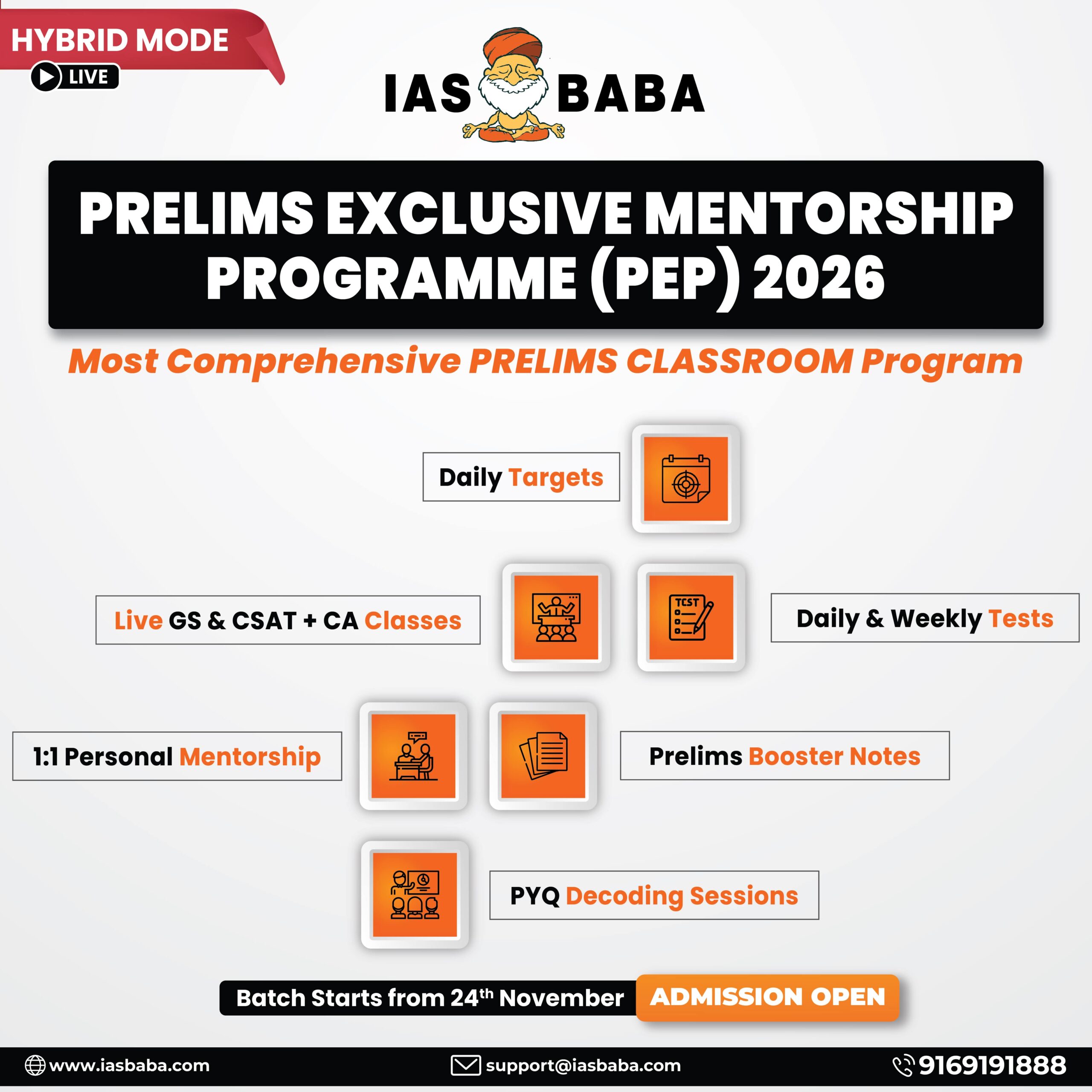IASbaba's Daily Current Affairs Analysis
Archives
(PRELIMS & MAINS Focus)
Syllabus:
- Prelims & Mains – CURRENT EVENT
Context: US President-elect Donald Trump has once again expressed interest in buying Greenland, and Greenland has again stated it is not for sale.
Background: –
- Greenland, though geographically part of North America, has been under Denmark’s control—located nearly 3,000 km (1,860 miles) away—for around 300 years.
Why Greenland matters to US?
- Greenland’s strategic importance rose during the Cold War, and the US has an air base there, the Pituffik Space Base, earlier the Thule Air Base. From Greenland, the US can monitor and prevent any missile coming towards it from Russia, China, or even North Korea. Similarly, it can launch missiles and ships towards Asia or Europe more easily from Greenland.
- Second, Greenland is rich in rare earth minerals. At present, China is a major supplier of these minerals.
- Third, as global warming leads to melting of ice, new waterways can open in the Arctic region, and all major powers are keen to boost their presence here. The US would want to pre-empt a larger Russian or Chinese role in Greenland and its neighbourhood.
US bought territories
- In 1803, the US bought more than 2 million sq km of land from France in what is known as the Louisiana Purchase. US paid $ 15 million for the deal.
- Another example is Alaska, which the Russian empire transferred to the US in 1867, for $7.2 million.
- In 1917, the US bought the Danish West Indies, a group of islands in the Caribbean, and called them the US Virgin Islands.
About Greenland
- Greenland, the largest island on Earth, is situated in the Arctic and is the most sparsely populated territory in the world. It is home to approximately 56,000 residents, primarily indigenous Inuit people.
- Around 80% of Greenland is covered by ice, with most of its population concentrated along the south-western coast near the capital, Nuuk.
- As an autonomous territory of Denmark, Greenland hosts both Danish and U.S. military bases. Its economy relies heavily on fishing, while substantial subsidies from the Danish government contribute about 20% of its GDP.
Source: Indian Express
Syllabus:
- Prelims & Mains – ENVIRONMENT
Context: A groundbreaking study, spearheaded by director of the Indian National Centre for Ocean Information Services (INCOIS), identified nine key algal bloom hotspots along India’s east and west coasts.
Background: –
- The research, done using cutting-edge satellite data and field reports, showed that factors driving these algal blooms range from nutrient flux during monsoons to coastal upwelling (cooler and nutrient-rich water rising to the ocean surface).
Key takeaways
- India’s coastline, rich in biodiversity, is grappling with a growing phenomenon of algal blooms. These events, caused by a sudden surge in phytoplankton biomass, are becoming more frequent and intense owing to environmental and human factors.
Causes of Algal Blooms
- Nutrient Pollution: Excessive nutrients, particularly nitrogen and phosphorus, from agricultural runoff, wastewater, and industrial discharges, fuel the growth of algae. This process is called eutrophication.
- Warm Water Temperatures: Algal blooms are more common in warm water, which is why they often occur in summer or in regions with higher temperatures.
- Stagnant Water: Slow-moving or stagnant water bodies, such as lakes or ponds, are more prone to algal blooms because nutrients accumulate and are not flushed out.
- Climate Change: Rising global temperatures and changes in precipitation patterns can exacerbate the conditions that lead to algal blooms.
- Human Activities: Urbanization, deforestation, and agricultural practices contribute to nutrient runoff, increasing the likelihood of blooms.
Types of Algal Blooms
- Harmful Algal Blooms (HABs):
- These blooms produce toxins that can harm aquatic life, humans, and animals.
- Examples include cyanobacteria (blue-green algae) blooms, which produce toxins like microcystins and anatoxins.
- Non-Toxic Blooms: Some algal blooms are not harmful but can still disrupt ecosystems by depleting oxygen levels in the water when the algae die and decompose.
- Examples of Harmful Algal Blooms
- Red Tide:
- Caused by dinoflagellates (a type of algae) in marine environments, leading to fish kills and respiratory issues in humans.
- Common in coastal areas like the Gulf of Mexico.
- Cyanobacteria Blooms: Often occur in freshwater lakes and ponds, producing toxins that can harm humans and animals.
- Red Tide:
Source: The Hindu
Syllabus:
- Prelims & Mains – CURRENT EVENT
Context: The Annual Status of Education Report (ASER) 2024 was released, revealing improvements in basic reading and arithmetic among students of classes 3 and 5 in rural areas reverting back from the post-pandemic damage.
Background:
- Unlike most other large-scale learning assessments, ASER is a household-based rather than school-based survey. This design enables all children to be included – those who have never been to school or have dropped out; those who are in government schools, private schools, religious or other types of schools; as well as those who are absent from school on the day of the assessment.
Key takeaways
- The Annual Status of Education Report (ASER) is a nationwide household survey conducted by Pratham Foundation, an NGO, to assess the status of children’s enrollment and learning outcomes in rural India.
- The ‘basic’ ASER survey tracks enrollment for children aged 3-16 and assesses basic reading and arithmetic of children aged 5-16. It was conducted every year from 2005 to 2014 in almost all rural districts of India.
- Beginning in 2016, an alternate-year model was introduced, where the ‘basic’ ASER survey is conducted in alternate years and in the gap years, a different lens is employed to examine different age groups and/or new aspects of children’s learning.
Key findings from ASER 2024
- Significant improvement in learning levels: The proportion of Class III students in government schools who can read a Class II textbook rose to 23.4 per cent in 2024, up from 16.3 per cent in 2022. Basic arithmetic levels among Class III students improved to 33.7 per cent in 2024, from 28.1 per cent in 2018, across both government and private schools.
- Enrolment trends: Government school enrolment, which surged during the pandemic, is now returning to pre-pandemic levels. It rose to 72.9 per cent in 2022, from 65.6 per cent in 2018, but has since dropped to 66.8 per cent in 2024. Overall school enrolment for 6 to14-year-olds stands at 98.1 per cent, close to 98.4 per cent in 2022.
- Decline in underage enrolment : The proportion of underage children (aged five or younger) enrolled in Class I has dropped to 16.7 per cent, the lowest level ever recorded.
- Out-of-school numbers: The number of out-of-school children in older age groups has continued to decline, remaining well below 2018 levels. However, there has been a slight increase compared to 2022 estimates.
- Gender gap in smartphone use : Among 14-16-year-olds, 85.5 per cent of boys and 79.4 per cent of girls reported knowing how to use a smartphone.
- Smartphone ownership on the rise : Household smartphone ownership in rural areas has grown significantly: 36 per cent in 2018, 74 per cent in 2022, 84 per cent in 2024.
- While access to smartphones at home is nearly saturated, personal ownership among 14-16-year-olds has climbed to 31 per cent in 2024, from 19 per cent in 2022. Since Aser surveyed smartphone access, ownership, and digital skills for the first time, there are no earlier numbers for comparison.
- Social media vs education
- Despite the rise in digital access, smartphone use for education remains limited.
- 82.2 per cent of teenagers know how to use a smartphone.
- Only 57 per cent use it for educational purposes.
- 76 per cent use it for social media.
Source: Business Standard
Syllabus:
- Prelims – GEOGRAPHY
Context: A powerful “bomb cyclone” named Storm Éowyn (pronounced AY-oh-win) pummeled parts of Ireland and the United Kingdom recently.
Background: –
- It is not unusual for winter storms in this part of the world to reach bomb cyclone status. However, only very few in recent years have shown a rate of deepening pressure that is comparable to that of Storm Éowyn.
Key takeaways
- A bomb cyclone, also known as explosive cyclogenesis or weather bomb, is a rapidly intensifying storm system characterized by a significant drop in atmospheric pressure.
- Definition: A bomb cyclone occurs when a mid-latitude cyclone’s central pressure drops by at least 24 millibars (mb) within 24 hours.
- Formation: It typically forms when a cold air mass collides with a warm air mass, often over ocean waters. This clash leads to a rapid drop in pressure and intensification of the storm.
Characteristics
- Rapid Intensification: The defining feature of a bomb cyclone is its quick strengthening, which can lead to severe weather conditions.
- Weather Impact: Bomb cyclones can bring heavy precipitation (rain, snow), strong winds, and coastal flooding. They can cause significant damage to infrastructure and pose risks to human safety.
Regions Prone to Bomb Cyclones:
- North America: U.S. East Coast, Great Lakes region, and Canada.
- Europe: North Atlantic regions, UK, and Scandinavia.
- Japan & East Asia: Occurs due to cold Siberian air masses interacting with warm ocean air.
Source: Weather
Syllabus:
- Prelims – CURRENT EVENT
Context: Security forces of the Democratic Republic of the Congo are fighting against Rwanda-backed rebels (named M23) who advanced into Goma, a key eastern city, in a major escalation of a decades-long conflict.
Background: –
- Sitting on the border with Rwanda and the shores of Lake Kivu, Goma is a vital trading and transport hub that is within reach of mining towns supplying metals and minerals in high demand such as gold, tin and coltan, which is a key component of mobile phones and batteries for electric vehicles.
Key takeaways
Who are the M23?
- The M23 are led by ethnic Tutsis, who say they needed to take up arms to protect the rights of the minority group.
- Shortly after its creation in 2012, the M23 rapidly gained territory and seized Goma – acts that were met with international opprobrium and accusations of war crimes.
- It was forced to withdraw from Goma, and then suffered a series of defeats at the hands of the Congolese army along with a UN force that saw it expelled from the country.
- M23 fighters then agreed to be integrated into the army in return for promises that Tutsis would be protected. But, in 2021, the group took up arms again.
- Neighbouring Rwanda has in the past consistently denied that it supported the M23, but ever since 2012 UN experts have accused it of providing weapons, logistical support and even ultimately commanding the rebels.

What is the connection with Rwanda?
- The origin of the current fighting can partly be traced back to the genocide in Rwanda in 1994. About 800,000 people – the vast majority from the Tutsi community – were slaughtered by ethnic Hutu extremists.
- The genocide ended with the advance of a force of Tutsi-led rebels commanded by Paul Kagame, who is now Rwandan president.
- Fearing reprisals, an estimated one million Hutus then fled across the border to what is now DR Congo. This stoked ethnic tensions as a marginalised Tutsi group in the east – the Banyamulenge – felt increasingly under threat.
- Rwanda’s army twice invaded DR Congo, saying it was going after some of those responsible for the genocide.
- After 30 years of conflict, one of the Hutu groups, the Democratic Forces for the Liberation of Rwanda (FDLR), which includes some of those responsible for the Rwandan genocide, is still active in eastern DR Congo.
- Rwanda is unlikely to stay out of DR Congo unless it is satisfied that the FDLR is no longer a threat to itself, or to the Tutsi communities in eastern DR Congo.
What about Congo’s mineral wealth?
- DR Congo and multiple UN reports have accused Rwanda of using the conflict as a way of looting Congolese minerals, such as gold and coltan, which is used to make batteries for electric vehicles and mobile phones.
- In recent years, the M23 has seized several lucrative mining areas and a report by UN experts said that around 120 tonnes of coltan was being sent by the M23 to Rwanda every four weeks.
Source: BBC
Practice MCQs
Q1.) Consider the following statements regarding algal blooms:
- Algal blooms occur only in freshwater lakes and do not affect marine ecosystems.
- Eutrophication caused by excessive nutrients is a major cause of algal blooms.
- Red tide is an example of a harmful algal bloom that can produce toxins affecting marine life.
Which of the statements given above is/are correct?
(a) 1 and 2 only
(b) 2 and 3 only
(c) 1 and 3 only
(d) 1, 2, and 3
Q2.) Consider the following statements regarding the Democratic Republic of the Congo (DRC):
- The DRC is located in West Africa and shares a border with the Atlantic Ocean.
- It is home to the Congo Rainforest, the second-largest tropical rainforest in the world after the Amazon.
- The DRC is rich in mineral resources, including cobalt and coltan, which are essential for electronic industries.
Which of the statements given above is/are correct?
(a) 1 and 2 only
(b) 2 and 3 only
(c) 1 and 3 only
(d) 1, 2, and 3
Q3.) With reference to algal blooms, consider the following statements:
- Algal blooms occur due to the excessive growth of algae in water bodies, primarily triggered by nutrient enrichment.
- Harmful algal blooms (HABs) can produce toxins that affect aquatic life, human health, and water quality.
- Algal blooms are always beneficial as they increase oxygen levels in water, supporting marine biodiversity.
Which of the statements given above is/are correct?
(a) 1 and 2 only
(b) 2 and 3 only
(c) 1 and 3 only
(d) 1, 2, and 3
Comment the answers to the above questions in the comment section below!!
ANSWERS FOR ’ Today’s – Daily Practice MCQs’ will be updated along with tomorrow’s Daily Current Affairs
ANSWERS FOR 28th January – Daily Practice MCQs
Q.1) – b
Q.2) – b
Q.3) – b













